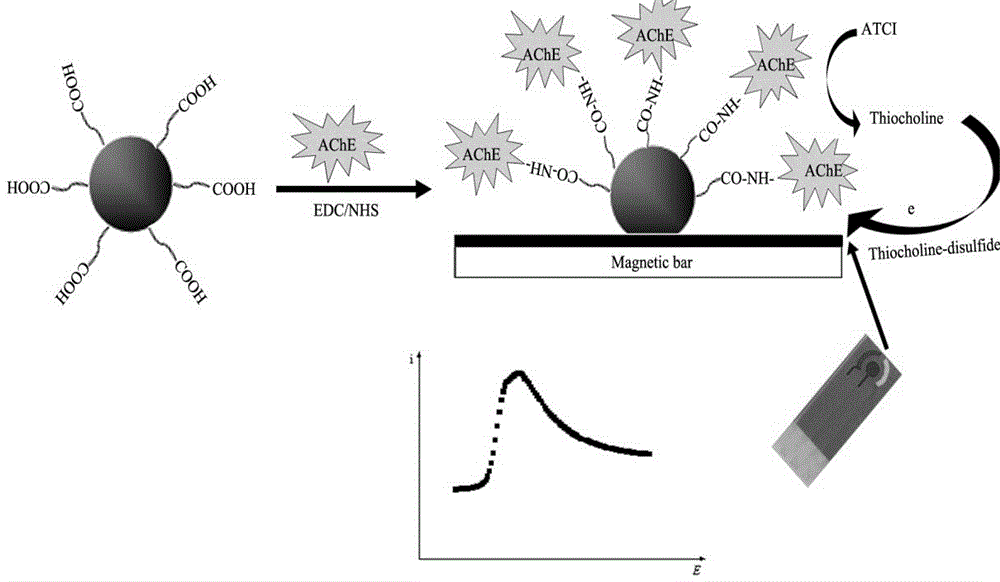Biosensor achieving AChE oriented immobilization and preparation method and application of biosensor
A biosensor, directional fixation technology, applied in the field of biosensors, can solve the problems of poor reproducibility of biosensors, complex working electrode composition, inability to meet micro-analysis, etc., to achieve good sensitivity and reproducibility, convenient storage and repeated reproduction. Utilize and simplify the effect of preparation
- Summary
- Abstract
- Description
- Claims
- Application Information
AI Technical Summary
Problems solved by technology
Method used
Image
Examples
Embodiment 1
[0027] Embodiment 1: a kind of preparation method of the biosensor of AChE enzyme orientation immobilization, it comprises the following steps:
[0028] S1. Preparation of magnetic nanomaterials: FeCl 3 ·6H 2 O and FeCl 2 4H 2 Fe with superparamagnetism obtained by magnetic separation after O reaction 3 o 4 Nanoparticles, adding TEOS reaction to generate silica wrapped Fe 3 o 4 Composite A with a core-shell structure of particles; wherein, the FeCl 3 ·6H 2 O and FeCl 2 4H 2 The weight ratio of O is 1:1; the reaction temperature of adding TEOS is 30°C, the reaction time is 5h, and the pH value of the reaction solution is 9, which is adjusted with ammonia water;
[0029] S2. Modification: first add APTMS to compound A to carry out amino modification reaction, the reaction temperature is 30°C, the reaction time is 6.5h, then add DMF and succinic anhydride magnetic stirring reaction for 2.5h, to obtain a magnetic compound with a carboxyl group modification at the end Na...
Embodiment 2
[0032] Embodiment 2: a kind of preparation method of the biosensor of AChE enzyme orientation immobilization, it comprises the following steps:
[0033] S1. Preparation of magnetic nanomaterials: FeCl 3 ·6H 2 O and FeCl 2 4H 2 Fe with superparamagnetism obtained by magnetic separation after O reaction 3 o 4 Nanoparticles, adding TEOS reaction to generate silica wrapped Fe 3 o 4 Composite A with a core-shell structure of particles; wherein, the FeCl 3 ·6H 2 O and FeCl 2 4H 2 The weight ratio of O is 3.5:1; the reaction temperature of adding TEOS is 40°C, the reaction time is 7h, and the pH value of the reaction solution is 10, which is adjusted with ammonia water;
[0034] S2. Modification: first add APTMS to compound A for amino modification reaction, the reaction temperature is 40°C, the reaction time is 7.5h, then add DMF and succinic anhydride magnetic stirring reaction for 3.5h, and the end is carboxyl modified magnetic Nanomaterial B;
[0035]S3. Preparation o...
Embodiment 3
[0037] Embodiment 3: a kind of preparation method of the biosensor of AChE enzyme orientation immobilization, it comprises the following steps:
[0038] S1. Preparation of magnetic nanomaterials: FeCl 3 ·6H 2 O and FeCl 2 4H 2 Fe with superparamagnetism obtained by magnetic separation after O reaction 3 o 4 Nanoparticles, adding TEOS reaction to generate silica wrapped Fe 3 o 4 Composite A with a core-shell structure of particles; wherein, the FeCl 3 ·6H 2 O and FeCl 2 4H 2 The weight ratio of O is 2.8:1; the reaction temperature of adding TEOS is 33°C, the reaction time is 9h, and the pH value of the reaction solution is 9, which is adjusted with ammonia water;
[0039] S2. Modification: first add APTMS to compound A for amino modification reaction, the reaction temperature is 32 ° C, the reaction time is 7 hours, then add DMF and succinic anhydride magnetic stirring reaction for 3 hours, and obtain the magnetic nanomaterial with carboxyl group modification at the e...
PUM
 Login to View More
Login to View More Abstract
Description
Claims
Application Information
 Login to View More
Login to View More - R&D
- Intellectual Property
- Life Sciences
- Materials
- Tech Scout
- Unparalleled Data Quality
- Higher Quality Content
- 60% Fewer Hallucinations
Browse by: Latest US Patents, China's latest patents, Technical Efficacy Thesaurus, Application Domain, Technology Topic, Popular Technical Reports.
© 2025 PatSnap. All rights reserved.Legal|Privacy policy|Modern Slavery Act Transparency Statement|Sitemap|About US| Contact US: help@patsnap.com

